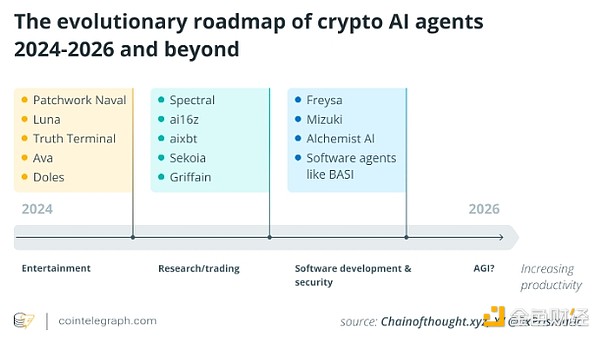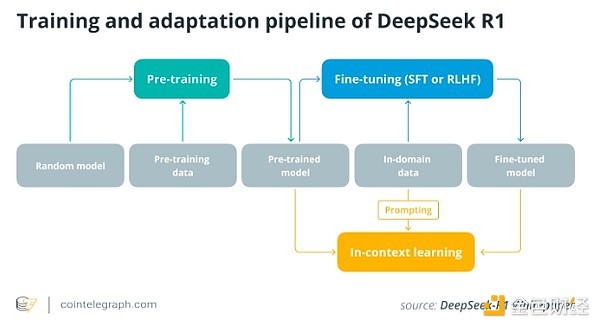Author: Iraklis A, CoinTelegraph; Compiler: Baishui, Golden Finance
The rise of AI-driven crypto agents follows a familiar trajectory, mirroring the initial boom, bust, and recovery of ICO-era projects. Just as early blockchain businesses thrived on hype before maturing into sustainable ecosystems, the current wave of AI agent projects is undergoing a rapid market shift.
Investors are becoming increasingly cautious as competition in the industry intensifies, liquidity is fragmented, and many projects struggle to define clear use cases, according to a new report from HTX Ventures and HTX Research. However, as the industry moves beyond the speculative phase, AI-driven crypto agents are expected to develop sustainable business models based on real utility.
From Meme Hype to Reality: The Evolution of Crypto Agents
The initial wave of crypto agent projects in 2024 was driven by enthusiasm for AI projects. Following the influence of Marc Andreessen’s donation of $50,000 in Bitcoin in October 2024 and the success of token offerings earlier this year, many AI agent projects entered the space in Q1 2024 and quickly diluted liquidity in Q1 2025. As with any emerging industry, early hype does not always translate into long-term viability, and the crypto AI agent industry subsequently entered a cooling-off period.
The market space is now entering a more mature phase, and the focus is shifting from speculative excitement to revenue generation and product performance. In this evolving environment, the winners will be those who can generate stable revenue, cover the costs of running AI models, and provide tangible value to users and investors.

AI agent applications emphasize the implementation and commercialization of the technology in the real world, especially in areas such as automated trading, asset management, market analysis, and cross-chain interaction. This approach is consistent with multi-agent systems and DeFAI (decentralized finance + AI) initiatives such as Hey Anon, GRIFFAIN, and ChainGPT.
Recent research has highlighted the advantages of multi-agent systems (MAS) in portfolio management, especially in cryptocurrency investments. Projects such as Griffain, NEUR, and BUZZ have demonstrated how AI can help users interact with DeFi protocols and make informed decisions. Unlike single-agent AI models, multi-agent systems leverage collaboration between specialized agents to enhance market analysis and execution. These agents operate in teams, such as data analysts, risk assessors, and trade execution departments, each trained to handle specific tasks.
The MAS framework also introduces an inter-agent communication mechanism, where agents in the same team improve their forecasts through collective learning, thereby reducing errors in market trend analysis. The next phase of DeFAI may involve a deeper integration of decentralized governance models, where multi-agent systems participate in protocol management, financial optimization, and on-chain compliance enforcement.
DeepSeek-R1: A Breakthrough in AI Agent Training
DeepSeek-R1 is a breakthrough in AI agent technology, an innovation that challenges traditional AI training methods. Unlike previous models, which relied on supervised fine-tuning (SFT) followed by reinforcement learning (RL), DeepSeek-R1 takes a different approach, optimizing entirely through reinforcement learning without an initial supervised phase. This shift significantly improves reasoning and adaptability, paving the way for more sophisticated AI-driven cryptographic agents.
To understand this paradigm shift, consider two different approaches to learning. In traditional SFT and RL models, students first learn from a workbook, practicing problems with fixed answers (SFT), and then receive coaching to refine their understanding (RL). In contrast, in the DeepSeek-R1 model (pure reinforcement learning), students directly take the exam and learn through trial and error. This approach allows students to improve dynamically based on feedback rather than relying on predefined answers.
With DeepSeek-R1's pure RL model, AI agents can learn through trial and error under real-world conditions and dynamically adjust their policies based on immediate feedback.
This approach is more adaptable and is particularly useful for multi-agent AI systems in DeFi, where real-time market fluctuations require agents to make autonomous, data-driven decisions. For example, AI-driven agents can monitor liquidity pools, detect arbitrage opportunities, and optimize asset allocation based on real-time market conditions. These agents can quickly adapt to market fluctuations, ensuring more efficient capital allocation.

iDEGEN was launched in late November 2024 and is the first crypto AI agent built on DeepSeek R1. This integration of DeepSeek’s R1 model highlights how crypto AI agents can inherit this enhanced reasoning capability, competing with other established AI models at a fraction of the cost.
The shift toward RL-driven multi-agent AI in DeFi automation highlights why closed-source AI models, such as OpenAI’s GPT-based system, are becoming an unsustainable expense. With workflows often requiring processing of over 10,000 tokens per transaction, closed AI models incur significant computational costs, limiting scalability. In contrast, open-source RL models like DeepSeek-R1 allow for decentralized, cost-effective AI development tailored for DeFi applications.
The Future of AI Agents in Web3
The key to longevity in this space lies in continued innovation, adaptability, and cost-effectiveness. Open-source AI models like DeepSeek-R1 are lowering the barrier to entry, enabling blockchain-native startups to develop specialized AI solutions. Meanwhile, advances in DeFAI and multi-agent systems will drive the long-term convergence between AI and decentralized finance.
The conclusion is clear: Projects must prove their value beyond the hype. Those who develop sustainable economic models and leverage cutting-edge AI advances will define the future of the smart blockchain ecosystem. The ICO era of crypto-agents is evolving, and the next wave of winners will be those who can turn innovation into long-term viability.
 Weatherly
Weatherly
 Weatherly
Weatherly Weiliang
Weiliang Miyuki
Miyuki Weiliang
Weiliang Weiliang
Weiliang Miyuki
Miyuki Weiliang
Weiliang Miyuki
Miyuki Brian
Brian Weiliang
Weiliang